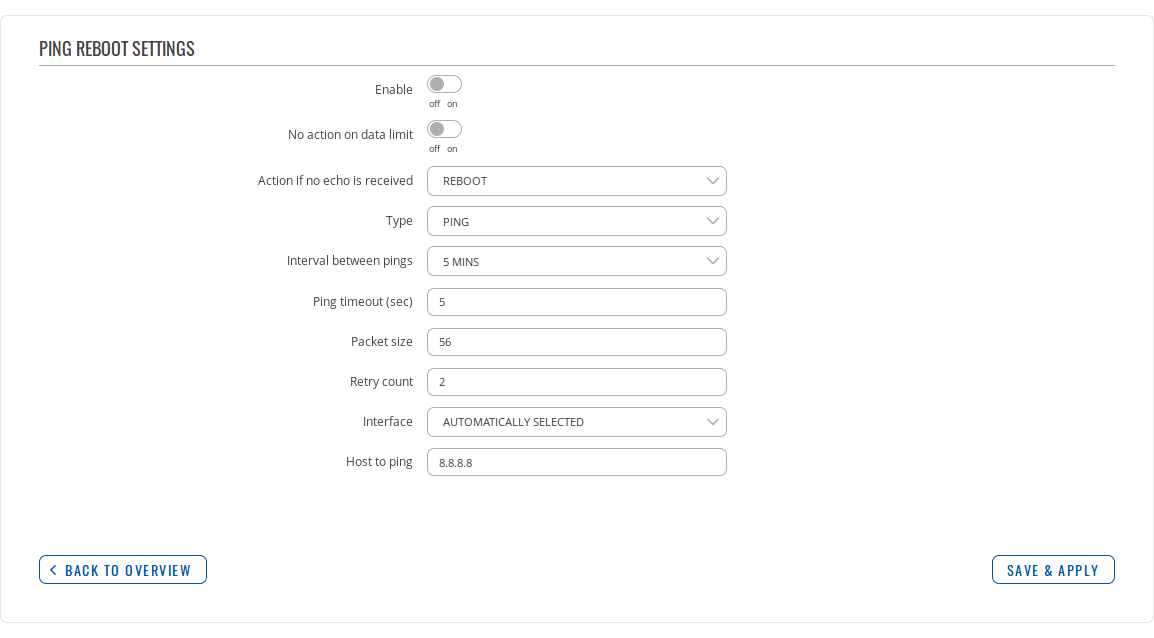Template:Networking rutos manual auto reboot
Summary
Various automatic device reboot scenarios can be configured in the Auto Reboot section. Automatic reboots can be used as a prophylactic or precautionary measure that ensures the device will self-correct some unexpected issues, especially related to connection downtime. This chapter is an overview of the Auto Reboot section of {{{name}}} devices.
The information in this page is updated in accordance with the [[Media:{{{fw_version}}}_single.bin|{{{fw_version}}}]] firmware version.
Ping Reboot
The Ping Reboot function periodically sends ICMP or Wget requests to a specified IP address or host and waits for a response. If no response is received, the device will attempt the same action a defined number of times at a defined frequency. If there is still no response, the device will execute the specified action (reboot, by default).
The Ping Reboot section contains one preconfigured rule by default:
To enable the default rule, use the off/on slider next to it. You can add more rules with the 'Add' button or delete them using the "Delete" button. If you wish to customize a rule, click the button that looks like a pencil next to it. Refer to the figure and table below for information Ping Reboot configuration.
| Field | Value | Description |
|---|---|---|
| Enable | off | on; default: off | Turns the rule on or off. |
| Action if no echo is received | Reboot | None; default: Reboot | Action that will be executed if there is no response after the specified amount of retries. |
| Type | Ping | Wget; default: Ping | Method used for health checking.
|
| Interval between pings | 5 mins | 15 mins | 30 mins | 1 hour | 2 hours; default: 5 mins | The frequency at which ping/Wget requests are sent to the specified host. |
| Ping timeout (sec) | integer [1..9999]; default: 5 | Maximum response time. If no echo is received after the amount of time specified in this field has passed, the ping/wget request is considered to have failed. |
| Packet size | integer [0..1000]; default: 56 | ICMP packet size in bytes. |
| Retry count | integer [1..9999]; default: 2 | Indicates how many additional times the device will try sending requests if the initial one fails. |
| Interface | Automatically selected; default: Automatically selected | Interface that will send the ping/Wget requests. |
| Host to ping | host | ip; default: 8.8.8.8 | Hostname or IP address to which the ping/Wget requests will be sent. |
Periodic Reboot
Periodic Reboot is a function that reboots the device at a specified time interval regardless of other circumstances. It can be used as a prophylactic measure, for example, to reboot the device once at the end of every day. Reboot time is chosen by selecting time interval boxes in the scheduler table to indicate on which days/hours reboot will occur.
The figure below is an example of the Periodic Reboot configuration page and the table below provides information on the fields contained in that page:
[[File:{{{file_periodic_reboot}}}]]
| Field | Value | Description |
|---|---|---|
| Enable | off | on; default: off | Turns Periodic Reboot on or off. |
[[Category:{{{name}}} Services section]]


